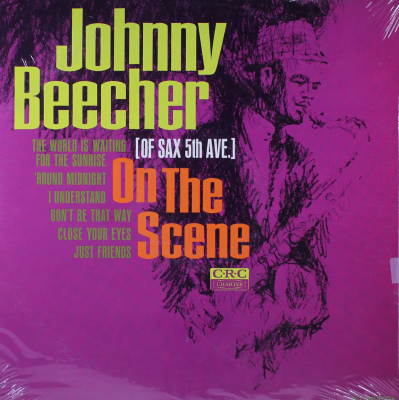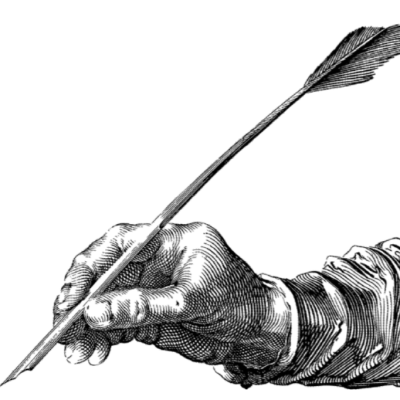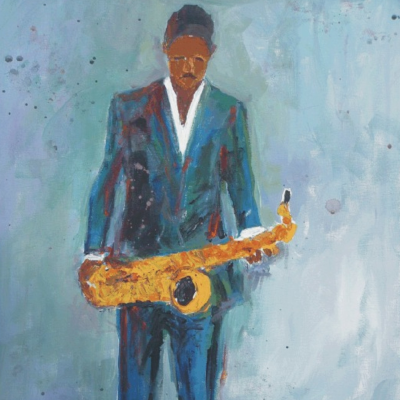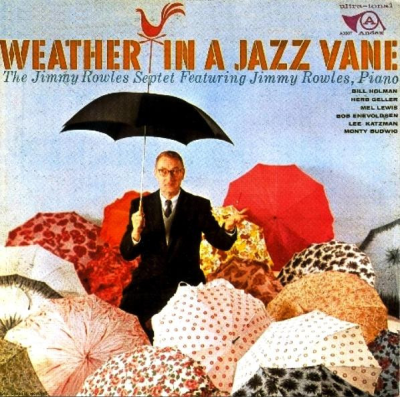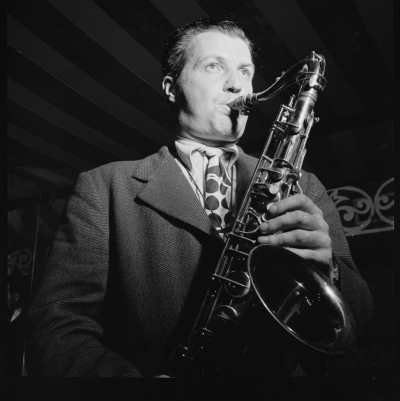.
.
William Gottlieb/Library of Congress

Adrian Rollini, sometime between 1938 and 1948
.
___
.
Adrian Rollini Lives
by Malcolm McCollum
.
…..Adrian Rollini had disappeared from the collective consciousness by the time he died in 1956, despite his long, much-recorded career in jazz. None of the first-generation jazz historians seemed to appreciate Rollini’s musical genius, or perhaps his quirky choices of instrument failed to fit into their explanatory schemes. Long before Charles MIngus observed that the beat exists inside a circle, Rollini was exploiting that sense of swing, both with his bass saxophone and with the vibraphone, and communicating that powerful pulse to everyone he played with. Of course, he played with some pretty extraordinary musicians, but he made everyone who ever played with him a better musician
…..Like Mozart, Rollini began as a piano prodigy, giving a recital at the Waldorf-Astoria at the age of four. But he abandoned the piano in his teens when a bass instrument was needed and he took up the monster of the sax family, the bass sax, which he mastered within weeks and on which he recorded with a remarkable range of jazz greats all during the 20s and 30s. Midway through the 30s, he added the vibraphone, recording with it well before Lionel Hampton, who’s generally considered the pioneer of that instrument. Rollini directed a medium-sized jazz orchestra, The California Rambers, and a variety of his own smaller groups well into the 1940s. He somewhat mysteriously died in the early 50s in Florida, where he was running a fishing camp.
…..And, also like Mozart, Rollini seems to have been born with an interior sense of polyrhythm, that feeling for a bunch of simultaneous rhythmic patterns you may hear any time you go out in nature, or that you’d hear if you made yourself aware of all the rhythmic patterns going on all the time within your body. A feeling for these, placed against an absolutely infallible feeling for the downbeat in some fixed meter, is what produces what’s known as “swing,” and, like Mozart, Rollini never played a note that didn’t swing.
…..One of the ways Rollini kept every band he ever took part in swinging was with pick-ups, those little phrases leading up to the first note of the phrase that starts on the down beat, little strings of three or four or five notes that suggest a rhythm pattern for the next solo.
…..A final comparison to Mozart: Rollini’s contributions, whether he was providing bass underpinnings, fills and pickups, or taking his own solos, were all infused with the kind of organic architectural logic you find in any skeleton. Each phrase suggested the next, or suggested its contrast, and all of them together made up a coherent melodic whole.
…..Forgive me for trying to explain what makes Rollini’s music so compelling. It’s enough to say that he generally played with some of the best musicians of his time, and in every case he brought out the best in them. Every recording he made – and he made hundreds – is filled with the joy of living that jazz at its best captures and recreates. I would say of Rollini what Jimmy Durante’s longtime vaudeville partner, Lou Clayton, said of Durante: ““Because he can walk into a dark room, and every bulb in that room can be burned out, and there’s no matches, and believe me, you will feel that room light up when that face of his gets inside it.”
…..He’s far from the only great musician to fall into obscurity. In his case, I think he’s been forgotten largely because his primary instrument, that fantastic behemoth the bass saxophone, fell completely out of the little favor it ever had, supplanted by the string bass. His secondary instrument, the vibraphone, was popularized by a superior showman (if not a superior vibes player), Lionel Hampton, who became nearly synonymous with the instrument while playing with Benny Goodman, probably the most popular jazz musician in the country for many years.
…..But Adrian Rollini has not been completely forgotten. His work lives on many compact discs, of which, as an introduction to the range of his work, I’d recommend the British compilation Tap Room Swing. You can also find any number of his performances in various contexts at Youtube by clicking here.
…..When the roaring, bloviating Romantics came along, and swept into popular favor, Mozart was pretty well forgotten for decades. The elegant flowering of early jazz has also largely been forgotten, replaced by narcissistic virtuosity and variously political posturing. But real music never dies, even if people’s taste for it goes dormant. Adrian Rollini does live.
.
.
___
.
.

Malcolm McCollum taught English literature and composition, humanities and music history for 35 years at Colorado colleges and universities. He has published Dmitri’s Agenda, The Guards, Translations from the Human (with Zigmund Steiner) (poetry), My Checkered Career and The Aim Was Song (memoirs), Can You Hear Me Now? and A Loose Canon (essays on media and literacy and favorite writers).
.
.
Listen to Adrian Rollini and His Orchestra play “Tap Room Swing” [The Orchard]
.
.
___
.
.
Click here for information about how to submit your work
Click here to read The Sunday Poem
Click here to read “A Collection of Jazz Poetry – Spring/Summer, 2024 Edition”
Click here to subscribe to the (free) Jerry Jazz Musician quarterly newsletter
Click here to help support the ongoing publication of Jerry Jazz Musician, and to keep it commercial-free (thank you!)
.
___
.
.
Jerry Jazz Musician…human produced (and AI-free) since 1999
.
.
.








